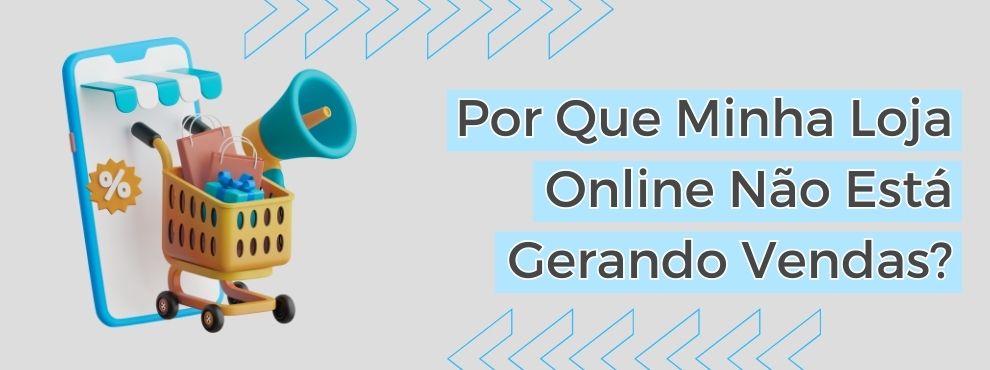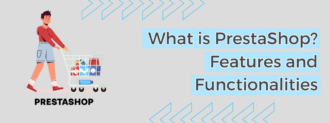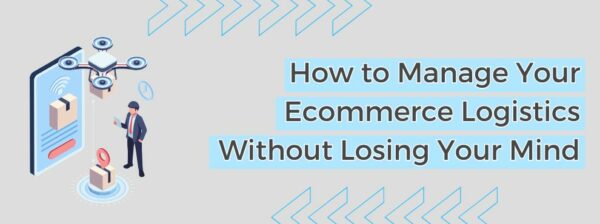If you’re here, it’s because you understand the importance of having an online store and how it impacts your business’s sales. The ability to reach customers from anywhere, having a catalog available 24/7, and the opportunity to sell at any time are just a few advantages of having an online store.
However, merely having an online store is not enough. Sometimes, when expectations are too high, believing that having an online store will automatically bring in revenue, many merchants may ask themselves, “Why isn’t my online store making sales?”
The lack of sales in an online store can be attributed to various factors, from visibility on search engines to user experience. However, a crucial aspect often overlooked is the absence of an effective online marketing strategy and a store design focused on conversion.
Therefore, I’ve created this post to analyze the reasons why an online project fails in its main mission—to sell—and how a combination of online marketing strategies, along with a focus on user experience and conversion optimization, can be the key to making the question “Why isn’t my online store selling?” a thing of the past. Let’s dive in!
Table of contents
Why Isn’t My Online Store Selling?
It’s the million-dollar question, isn’t it? Even if it seems like your online store has everything to succeed, sometimes the numbers just don’t add up. Let’s break this down a bit to understand what’s happening behind the scenes.
First, let’s talk about visibility. If no one knows your store exists, they’ll hardly be able to make a purchase. Imagine your online store as a deserted island in the vast ocean, the Internet. Without a lighthouse guiding navigators, your island will remain inaccessible. This is where SEO is crucial to make your store visible to your customers, those navigators of the ocean, and appear in the top results when they make relevant product queries.
Now, suppose you already have visitors to your store. The question is, what do they do? Do they browse? Do they make purchases? This is where user experience (UX) comes into play. An online store should not only be attractive but also easy to use. If your visitors get lost trying to find what they came for or abandon the cart because the checkout process is too cumbersome, there’s your answer.
Last but not least, let’s talk about the online marketing strategy. Having a presence on social media, sending newsletters that people actually want to read, and leveraging advertising campaigns on platforms like Google Ads or Meta are fundamental for both acquisition and retention. Without all of this, you’re likely to keep asking yourself, “Why isn’t my online store making sales?”
Usability and Conversion Optimization in Online Stores
Now that we know that without visits there is no paradise and without a good user experience even less, let’s talk about turning those digital strolls through your store into actual sales. Because, at the end of the day, what matters is that the shopping cart gets filled and reaches the finish line. Let’s see how we can make this happen.
Ease of Navigation: Imagine entering a physical store and not finding what you’re looking for, or worse, seeing such disorder that you decide to leave without buying anything. Well, this also happens in online commerce. A clear menu, a search engine like Doofinder that shows what visitors are looking for, and well-defined categories are essential to prevent your customers from getting lost before finding what they’re looking for.
Loading Speed: Without delving into SEO, which we’ll address later, this is a fundamental factor for the user experience in your online store. If your page takes too long to load, it’s likely that your visitors will leave before even seeing what you offer. Optimizing images and resources, as well as choosing a good hosting service for PrestaShop, will make a difference.
Simplified Checkout Process: Every additional step in the checkout process is an opportunity for the customer to abandon their cart. My advice? Keep it simple. From selecting the product to payment, every click matters. And, of course, offer as many payment options as possible; you never know which one your customer will feel most comfortable with.
Mobile Optimization: Did you know that more than half of visits to online stores are made from mobile devices? If your store is not designed to be easy to use and make purchases from a mobile phone, you’re closing the door to more than half of your potential sales. Make sure the “add to cart” button is always visible, elements are adapted to the smartphone screen, and see the difference.
Online Marketing Strategies to Increase Sales
Having reached this point and knowing that your online store needs an online marketing strategy to sell, as well as a good user experience, let’s see how to make your online store attract quality traffic that converts into sales. Because, yes, at the end of the day, having an online store is useless if it doesn’t translate into sales and revenue.
SEO Strategy
It’s time to talk about my favorite part—SEO. As mentioned earlier, without an SEO strategy, your online store is a beautiful deserted island in the middle of a vast ocean. It might be that, from time to time, someone stumbles upon your online store. However, with a more long-term vision and creating an SEO strategy for Ecommerce, we’ll start attracting not only castaways but also determined navigators ready to buy your products.
And how do we do this? A SEO strategy is based on Technical SEO, Content, Link Building, and optimizing loading times considering Google’s algorithm. Let me detail these:
- Technical SEO: Auditing your project is essential to detect coding issues that may hinder Google’s crawling and indexing. Factors such as 3xx, 4xx, or 5xx errors, as well as poor configurations of robots.txt or sitemaps, can make your online store invisible and affect sales.
- Content: Just like with the technical part, it’s essential to conduct a keyword audit to understand why customers search for your products. Also, it’s important to define search intent and differentiate between informational and transactional needs. Therefore, we’ll also define a content strategy for both categories and products and for the blog.
- Link Building: As important as the above is to create a Link Building strategy, or in other words, build popularity on Google. Generating links from external websites to ours is essential, and these links must be carefully crafted and come from trustworthy sites.
- Web Performance Optimization (WPO): Finally, since the implementation of Core Web Vitals, optimizing the loading times of your online store has become a fundamental pillar. Therefore, it’s not only important to optimize it but also to periodically review it to maintain optimization over time.
Advertising Campaigns on Google Ads and Google Shopping
Just as with an SEO strategy, we’ll make our island visible within the ocean, with advertising campaigns on Google Ads and Google Shopping, we’ll make travel agencies sell tickets to our online store. These types of strategies work well to quickly generate visibility and traffic and are a good complement to SEO.
- Google Ads Campaigns: Within the campaigns we can run on Google Ads, I would highlight search network, display, and remarketing campaigns. The first ones complement organic search results, while the display campaigns increase visibility on websites like newspapers, blogs, or email platforms. Finally, well-managed remarketing will ensure that visitors interested in a product see your ads and return to make a purchase.
- Google Shopping: Of course, as a good ecommerce practice, Google Shopping campaigns are generally essential. Having your entire product catalog in Google’s Shopping tab makes your products more visible and quickly reaches potential consumers.
Email Marketing
Now that we have defined the customer acquisition strategy, it’s time to retain them because, as you know, it’s harder to acquire a customer than to keep them loyal. That’s why email marketing strategies become crucial in the life of your ecommerce.
- Newsletter Strategies: A proper email communication strategy with your customers will help remind them that you exist and keep them informed about your company. Therefore, it’s important to create a recurring email strategy with updates, blog posts, or promotions from your online store that may interest them.
- Marketing Automation: Personally, I love this part. Automating rules for email sending is super effective and very interesting. You can set up rules for new customers, recurring products, or recovering abandoned carts. It’s a fundamental strategy that greatly helps increase the revenue of your online store.
Conclusion
Transforming the question “Why isn’t my online store making sales?” into a thing of the past is entirely achievable. The key is to strategically address every aspect of your online presence, from search engine visibility to user experience and customer loyalty.
By implementing effective SEO tactics, leveraging Google Ads and Google Shopping campaigns for acquisition, and nurturing lasting relationships through email marketing and marketing automation, you can create a digital ecosystem that not only attracts visitors but turns them into loyal customers.
Remember, the success of your online store is a continuous journey of optimization and adaptation. It’s time to take action and see how your sales start to blossom!
Related Posts










Deja un comentario